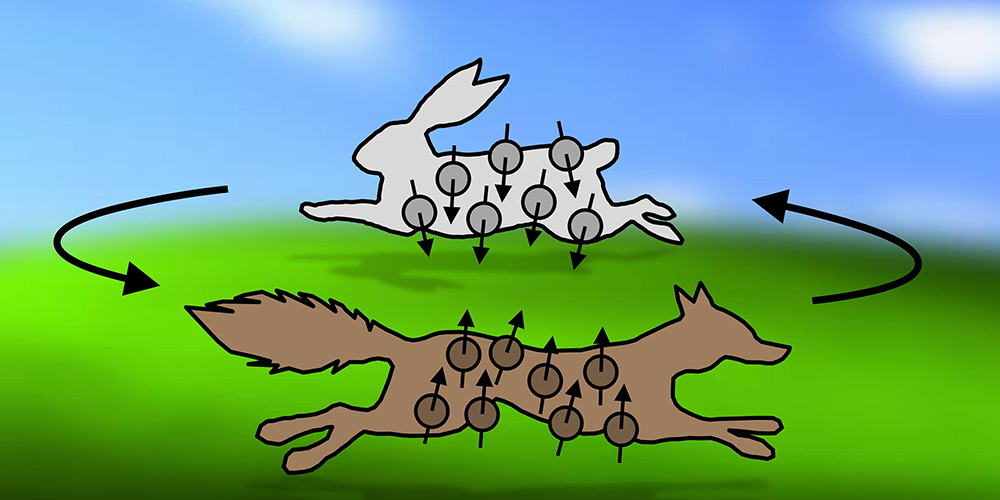Fox and rabbit in the quantum world
Researchers at the University of Basel have shown that quantum systems can have antagonistic interactions, too – one agent attracts the other, but the other way around, there is a repulsion. Such interactions could be realized using cold atoms that are coupled to each other.
23 January 2025 | Oliver Morsch
In our physics lessons we learned that like charges repel each other, but unlike charges attract each other. Note the “each other” here: charge A attracts charge B, and charge B attracts charge A. This sounds intuitive and obvious. However, nature is often not that mutual; for instance, when predators and prey are involved, the fox is attracted to the rabbit and chases it, but the rabbit runs away from the fox. As long as the fox does not catch the rabbit, this results in a kind of dynamic that can also be seen in other systems of so-called active agents such as nanoparticles or colloids, in which particles are finely distributed inside a medium.
The physicists Tobias Nadolny, Prof. Christoph Bruder, and Dr. Matteo Brunelli at the University of Basel have shown that such antagonistic or opposing interactions (A attracts B, B repels A) could theoretically exist in the quantum world. Their work, recently published in the scientific journal Physical Review X, also provides a recipe for realizing antagonistic quantum interactions in practice.
Antagonistic interactions in open quantum systems
“It wasn’t clear if there could be antagonistic interactions in quantum physics since the mathematical formulas typically result in a mutual or reciprocal interaction,” says PhD student Tobias Nadolny. To still create a quantum-physical predator-prey situation, the researchers resorted to open quantum systems. In such systems, energy can constantly be supplied to the quantum particles from the outside, for instance in the form of light, which causes them to become “active.” Moreover, the particles need to influence each other in a specific way to create an antagonistic interaction.
“Initially we had no idea whether this was going to work at all,” says postdoc Matteo Brunelli, “and it took some lengthy calculations to get the result.” That result, however, was unequivocal: quantum particles can, indeed, behave like foxes and rabbits, with all that entails. One of the consequences is that the quantum system never reaches a static resting state but is constantly in motion.
This can, for instance, lead to the formation of time crystals, in which a particular dynamic periodically repeats itself without any rhythm being imposed from the outside. “This is similar to a normal crystal, in which the spatial symmetry is spontaneously broken, causing the atoms to arrange themselves in a regular fashion – except that this order does not arise in space, but in time,” explains Brunelli, who is now conducting his research at the Collège de France.
Realization with coupled atoms
According to the Basel researchers, such an open quantum system could be realized using atoms that are constantly driven by laser light. Two spatially separated groups of such atoms are then coupled to each other by two waveguides (such as fiber optic cables) in such a way as to allow light to travel only from right to left in one waveguide and from left to right in the other waveguide.
Under certain conditions, this can result in an antagonistic interaction between the phases of the atomic spins, which can be imagined as little rotating arrows: the phases in group A (which tell us at which point the spins are in their rotation cycle) want to align with those of group B, whereas the phases in group B try to differ as much as possible from those of group A.
“We hope that our results will inspire other researchers to look into quantum systems with antagonistic interactions,” says Nadolny. He already has some practical applications in mind as well. The insights gained by the researchers could, for instance, contribute to the realization of particularly robust clockworks in atomic clocks.
Original publication
Tobias Nadolny, Christoph Bruder, and Matteo Brunelli
Nonreciprocal synchronization of active quantum spins
Physical Review X (2025), doi: 10.1103/PhysRevx.15.011010


